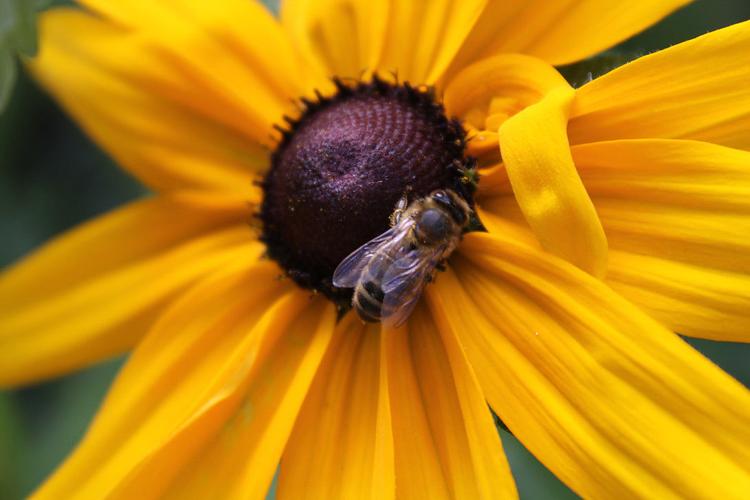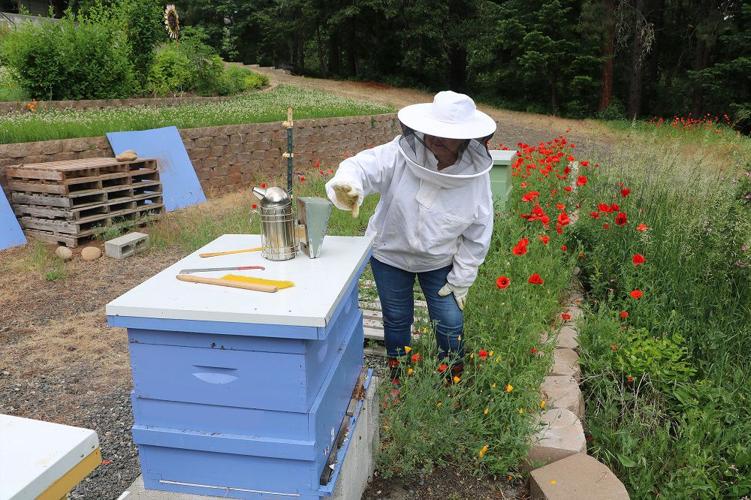Whether you find them fascinating, terrifying, or some mix thereof, everyone benefits from having bees around. Not only are bees essential to the Columbia River Gorge’s ecosystem and thriving agricultural industry, they can teach us a lot about nature and social structures, if we’re willing to learn. A wide variety of local resources — listed below — are available for those interested in taking up beekeeping themselves, helping native bees and other pollinators, or just learning more.
Columbia Gorge Beekeepers Association (CGBA): A non-profit associated with the Oregon State Beekeepers Association that holds a monthly meeting the third Wednesday of each month, starting 6:15 p.m. at the OSU Agricultural Extension Center. Each meeting includes a demonstration using the hives at the Extension service and a presentation by an entomologist or experienced beekeeper. Some CGBA members also participate in a bee removal program, where they respond to reports of bee swarms and other bee-related problems. For more information or to report a swarm, visit www.gorebeekeepers.org.
Oregon State Beekeepers Association (OSBA): While the CGBA is the local branch and is the best way to connect with local beekeepers, the parent-organization hosts an annual beekeeping conference, which will be Oct. 25-27 this year. OSBA’s website, orsba.org, also includes some educational material and online forums on a variety of topics.
BG Bees LLC: A beekeeping outfitter, consulting service and education center, owned and operated by Hood River resident and beekeeper Charlie Vanden Huevel. Visit bg-bees.com for more info.
Oregon Master Beekeeper Program: An educational program supported by the Oregon State Beekeepers Association and Oregon State University’s Bee Lab with the goal of improving and maintaining the health of honeybee colonies throughout the region. Beekeepers get hands-on experience working with bees and opportunities for training and mentorship. There are three successive levels to the program: Apprentice, Journey and Master. Visit extension.oregonstate.edu/mb for more info.
The Oregon Bee Project: A cooperative effort between the Oregon Department of Agriculture, OSU Extension Service, the Oregon Department of Forestry and other stakeholders, with the goal of maintaining and enhancing bee health in Oregon. The project hosts the Oregon Bee Atlas, a volunteer-driven effort to help survey varieties of bees in Oregon, and a Flagship Farm program for farmers using pollinator-friendly practices. The project’s website, www.oregonbeeproject.org, also includes a wide variety of educational resources for beekeepers, gardeners, farmers, educators, and more.
Operation Pollinator: An initiative through Syngenta, a global agricultural company, to help restore pollinators by creating pollinator-friendly habitats on agricultural land, golf courses and other landscapes. The program connects landowners with region-specific wildflower seed mixtures and information on how to establish and maintain pollinator-friendly habitats. More info at www.syngenta-us.com/beehealth/operationpollnator.aspx.
Aren’t all the bees dying? How can I help?
While honeybees aren’t technically endangered, bee populations have suffered greatly in recent years due to mites, disease, habitat changes and pesticide poisoning, among other factors.
Organizations such as the Columbia Gorge Beekeepers Association (CGBA) take an annual survey of hives that were lost over the winter in an effort to try and identify solutions — but the causes of colony collapse aren’t always evident. “There is no simple answer to explain the levels of current losses nor is it possible to demonstrate that they are necessarily excessive for all the issues facing honeybees in the current environment,” reads a statement in CGBA’s 2018 Winter Loss Report.
CGBA documented a 36 percent loss in the Gorge for the winter of 2017-18 — 2 percent lower than the statewide loss, 38 percent. “There appears to be no single reason for loss and a good deal of variance in opinion as to what might be an acceptable loss level,” states the report.
“We are dealing with living animals which are constantly exposed to many different challenges, both in the natural environment and the beekeeper’s apiary.”
Given how hard it is just to keep bees alive, it can be hard to imagine why someone would want to take up beekeeping in the first place. After all, beekeeping isn’t cheap — a standard Langstroth hive alone can cost over $200 and the bee colonies themselves are an additional $50-$200, and costs can easily skyrocket once you start adding in beekeeping classes and additional gear — and bee stings are uncomfortable at best, life-threatening at worst.
Keeping bees yourself isn’t necessarily the best way to help bee populations — and it certainly isn’t the only option.
Honeybees are just one of over 4,000 types of native and non-native bees in North America, and there are plenty of things people can do to help them out besides beekeeping, such as planting more native wildflowers, switching over to safe pesticides — or even setting up “bee hotels,” made of cardboard tubes, for mason bees to lay their eggs in.
But despite its challenges, beekeeping can be extremely rewarding, if done right. In addition to an annual honey harvest, beekeepers have cited the joy of seeing that their hives have survived the winter and the process of learning more about bees and the environment as reasons why they’ve continued the practice. Bees are essential pollinators and backyard beekeeping — if done right — can be a fun and educational hobby.
But what if I get stung?!
Bees, despite being generally mellow and kind of cute (in a buggy sort of way), incite an instinctive fight-or-flight reaction in most people — likely due to the venomous stinger sticking out of its backside and the bee’s similarity to its aggressive cousins: Wasps.
Physically, wasps have shiny, sleek bodies with little to no hair, whereas bees are thicker and covered in fuzz. Unlike bees, wasps are scavengers and are capable of stinging multiple times. Bees, on the other hand, lose their stingers and die after stinging once, so they will typically only sting when they feel threatened.
A lot of beekeepers will wear protective gear when dealing directly with beehives, but beekeeper Charlie Vanden Huevel says that the best protection is just staying calm. “If you’re not calm, the bees are going to know it and they’ll come after you,” he said.
If you do get stung, removing the stinger right away, applying an ice-pack and taking an over-the-counter antihistamine can help with recovery. Because bee stingers are curved, Vanden Huevel said that scraping them off with a fingernail or credit card is usually the most effective method of removal.
Swelling and pain from a bee sting are normal and typically don’t require emergency attention, but severe reactions such as nausea or difficulty breathing are signs to get immediate medical care.
Swelling and pain from a bee sting are normal and typically don’t require emergency attention, but severe reactions such as nausea or difficulty breathing are signs to get immediate medical care.
Vanden Huevel recommends driving to the ER and waiting in the parking lot, just in case, because “there’s no way to know what kind of reaction you’re going to have,” even if you’ve had only mild reactions in the past.
“Allergies are really funny things and you don’t know which direction they’re going to go,” he said.
“Allergies are really funny things and you don’t know which direction they’re going to go,” he said.



























Commented
Sorry, there are no recent results for popular commented articles.